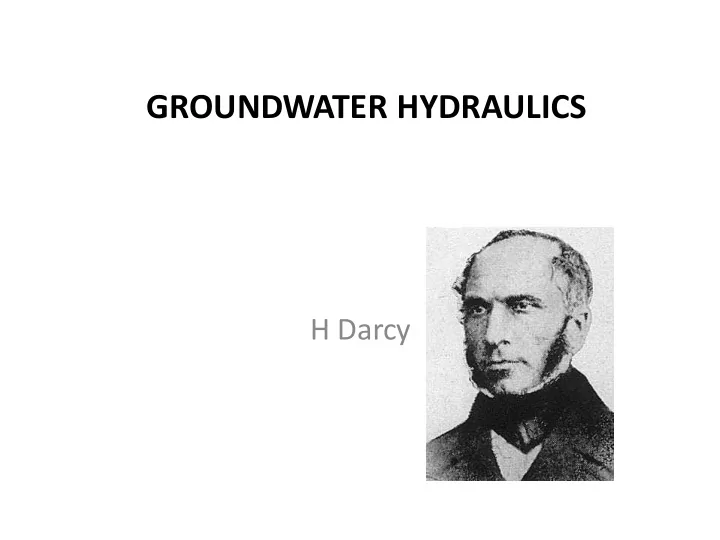

GROUNDWATER HYDRAULICS H Darcy
DEFINITIONS • Ground water is a major source of water supply. It needs very little treatment • Vadose zone is a partially saturated zone above the water table. Capillary forces play a major role in it • Aquifer is a geological formation that contains and transmits groundwater. Velocity of groundwater is less than 1m/day • Aquiclude is an impermeable geological formation (clay, shale etc.)
DEFINITIONS (cont.) • Confined aquifer is an aquifer confined by two aquicludes. Recharge occurs through outcrops • Unconfined aquifer is an aquifer with free water surface for an upper boundary. Recharge takes place through the ground surface above the aquifer. In case a stream crosses an aquifer, either the stream will recharge the aquifer or groundwater will discharge into the stream in the form of springs along the channel • Volumetric porosity ,
DEFINITIONS (cont.) • Specific yield is the fractional volume of water that will drain freely by gravity from a unit volume of the formation. If water table elevation for an unconfined gravel aquifer is lowered by 1m, a yield of 0.22 m 3 /sq.m is expected • Safe yield is the amount of groundwater that can be withdrawn without impairing the aquifer as a water source
Types of Aquifers
Creeping motion • In 1856, H. Darcy found experimentally that the seepage velocity (averaged over pores and solid region) is given by where, k is the hydraulic conductivity, m/s H is the piezometric head, m v x is the superficial velocity, m/s • Through the pores, the seepage velocity = .
Creeping motion (cont.) • For creeping flow in a gap of height b we had found • For a stream-tube in a porous media, b is proportional to the particle size diameter. Thus, • By comparing this with Darcy’s equation, the hydraulic conductivity,
Creeping motion (cont.) • Intrinsic permeability depends upon the physical properties of the porous medium • Hence, or • Conductivity ( k ) depends on both physical properties of the porous medium and the fluid properties. • Let us consider Darcy’s law in Rectangular Cartesian component form , and
Creeping motion (cont.) • For isotropic material, k is the same in all directions. Substituting in the continuity equation, we get • H behaves like the potential function • Darcy’s law is valid for .
Bore-well
Steady State Equation for Wells • After a well has been pumped for an extended period, steady state conditions are approached • In the simplest possible case, use Darcy’s equation for an isotropic, homogeneous aquifer • a) Confined aquifer Or
Steady State Equation for Wells (cont.) • Therefore, where T is known as the transmissivity and is equal to ( bk ). The above equation is known as Thiem equation • Drawdown = H – h = • Where, R is the radius of influence and r w is the radius of well
Recommend
More recommend